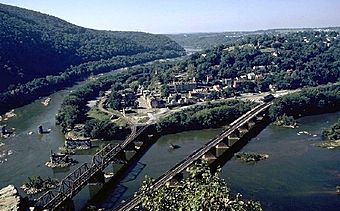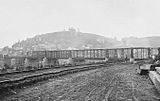- This page was last modified on 6 November 2023, at 08:11. Suggest an edit.
B & O Railroad Potomac River Crossing facts for kids
|
B & O Railroad Potomac River Crossing
|
|

Aerial view looking west. Left to right: Stone piers from 1851 Bollman bridge; 1894 bridge; 1931 bridge.
|
|
| Location | Harper's Ferry, West Virginia |
|---|---|
| Built | 1839 |
| Architect | Wendel Bollman |
| Demolished | 1936 (flood) |
| NRHP reference No. | 78001484 |
| Added to NRHP | February 14, 1978 |
The Baltimore and Ohio Railroad Crossings at the Potomac River are a set of railroad bridges that span the Potomac River between Sandy Hook, Maryland, and Harpers Ferry, West Virginia, in the United States.
History
The original Harper's Ferry operated from 1733 until it was replaced by a timber covered road bridge in about 1824 at the confluence of the Potomac and Shenandoah Rivers.
Built in 1836–1837, the B&O's first crossing over the Potomac was an 830-foot (250 m) covered wood truss. It was the only rail crossing of the Potomac River until after the Civil War. The single-track bridge, which comprised six river spans plus a span over the Chesapeake and Ohio Canal, was designed by Benjamin Henry Latrobe, II. In 1837 the Winchester and Potomac Railroad reached Harpers Ferry from the south, and Latrobe joined it to the B&O line using a "Y" span.
John Brown used the B&O bridge at the beginning of his failed attempt to start a slave insurrection in Virginia and further south.
The bridge was destroyed during the American Civil War, and replaced temporarily with a pontoon bridge.
The two crossings today, which are on different alignments, are from the late 19th century and early 20th century. A steel Pratt truss and plate girder bridge was built in 1894 to carry the B&O Valley line (now the CSX Shenandoah Subdivision) toward Winchester, Virginia, along the Shenandoah River. This was complemented in 1930–1931 with a deck plate girder bridge that carries the Baltimore and Ohio Railroad (B&O) main line to Martinsburg, West Virginia (the line is now the CSX Cumberland Subdivision).
A rail tunnel was built at the same time as the 1894 bridge to carry the line through the Maryland Heights, eliminating a sharp curve. In the 1930s the western end of the tunnel was widened during the construction of the second bridge to allow the broadest possible curve across the river.






